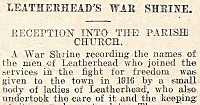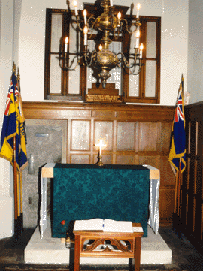LEATHERHEAD WAR MEMORIALS
DORKING AND LEATHERHEAD ADVERTISER, EPSOM DISTRICT
TIMES, AND COUNTY POST,
SATURDAY, DECEMBER 10, 1921

LEATHERHEAD'S WAR SHRINE
RECEPTION INTO THE PARISH CHURCH
A War Shrine recording the names of the men of Leatherhead who joined the services in the fight for freedom was given to the town in 1916 by a small body of ladies of Leatherhead, who also undertook the care of it and the keeping of its record up to date. These were: Miss Atkins, Miss A. Brown, Mrs. Finké, Miss O. Finké; Miss M Leach, Mrs Still, Miss M. Still, and Miss G. Wanklyn (who acted as secretary of this War Shrine Committee). The Shrine was dedicated by the Lord Bishop of Winchester, on March 21st., 1917. It was placed by the town clock. After the unveiling and dedication of the War Memorial on April 3rd last, the War Shrine Committee desired that the Shrine should find its permanent home in the Parish Church. To this, the War Memorial Committee, as representing the whole body of the inhabitants of Leatherhead in the matter, cordially agreed. The above-mentioned ladies (Mrs. Clarke Kennedy taking the place of her mother, Mrs. Finké, who died last Spring) also presented a Union Jack to be placed above the Shrine. The necessary faculty having been obtained, the Vicar decided that as this was a matter which concerned all the people of Leatherhead of whatever shade of religious opinion, the formal acceptance of the Shrine and the dedication of the flag to surmount it should take place at a special united service.
The service took place last Sunday afternoon. To many minds, it was the most impressive service in connection with the war held in Leatherhead since the Armistice. There was no ceremonial as at the unveiling of the War Memorial. It was a service of beautiful simplicity in which all present joined with a touching sincerity - a service of praise and gratitude to the Giver of the great victory in which the sons of Leatherhead! shared so nobly. The desire to honour the brave had dissolved all small differences of religious opinion; the congregation was inter-denominational, and Nonconformist ministers took their parts with the clergy of the Church of England in the service. The Church had become the Parish Church in fact. It was the Church of all the parishioners. Would that it could be more often so!
The Church was well filled. The congregation included all the members (with one exception) of the Leatherhead Urban District Council, and representatives of the Council's staff, officials and members of the Leatherhead Brotherhood, and the local troop of Boy Scouts. The clergy present were the Vicar of Leatherhead, the Rev. H.M. Brook (Wesleyan), the Rev. E. A. Downes (Headmaster of St. John's School), the Rev. J. W. St. Clare Hill (Principal of the Royal School for the Blind), and the Rev. H. L. Sumner (Congregational).
FIGHTING FOR PEACE
The service opened with the processional hymn, "Soldiers who are Christ's." The Lesson - Wisdom 3, 1-6 - was read by the Rev. H. E. Sumner, and Psalm 23 was chanted. Then followed an address. This was delivered by the Rev. H. M. Brook, and was a stirring exhortation to all people to strive for permanent peace among the nations.
Mr. Brook said (in part): We ought to express our gratitude to those who laboured and toiled and fought for their country during the perils of the war. They endured many hardships and trials, and their names must be held among us in eternal honour. This afternoon, we think especially of those who made the last supreme sacrifice - those who, in the spring-time of life, poured out the rich, red wine of youth and died that others might live. They died that government; of the people, by the people, for the people should, not perish from the earth. There are words in the King's message to the relatives and friends of the fallen that are particularly appropriate and express a profound truth. They were: 'They trod the path of duty and they passed out of the sight of man.' They are no longer visible to our mortal sight, but they have not passed out of the sight of God. They are not dead; they are living with God. Christ died on behalf of others; died that the light which shines from His open tomb may shine in our hearts and illumine the darkness of bereavement, and give us the assurance that those whom we mourn are living, still in the great service of God.
"What, was the purpose of the great sacrifice they made? It was in order to make an end of war. They fought for an abiding peace. They strove that there might be an end of strife. That was the inspiration of the stupendous sacrifice they made. But they did not finish the work, they could not. Death came, and they have left us to carry the work on. Let us dedicate ourselves to the great task which they left unfinished - securing abiding peace throughout this troubled and weary world. Let us pray and work for peace. Let us support with all our might the Conference at Washington, with its great call to the nations for disarmament and peace. Let us pray for and support with all our strength the League of Nations. Let all nations be bound together in one great league of peace, brotherhood and goodwill. Let us labour, let us strive, let us pray for the coming of the time when peace, like a shaft of light, shall lie across the land, like a lane of beams lie athwart the sea.
When the war-drums throb no longer
and the battle flags are furled,
In the Parliament of Man, the
Federation of the World!
These things shall be: 'A nobler race than e'er the world has seen shall rise with flame of freedom in their souls and light of knowledge in their eyes.' "
Following this address, the hymn "O valiant hearts" was sung, and then the Vicar, accompanied by Miss O. Finké and Lieut. Col. W. A. Gillett, carrying the Union Jack, moved to the Altar step where the flag was presented by Miss Finké and dedicated. The clergy and choir then moved in procession to the West end of the north aisle, where the Shrine had been erected. Miss Brown asked the Church to receive the Shrine and, on behalf of the Church, the Vicar accepted it and undertook responsibility for its care. The flag was placed above the Shrine. Prayers were said by the Vicar, and as the procession returned to chancel the hymn "For all the Saints" was sung. The Collect for All Saints' Day and the Blessing followed. The service ended with the playing of the Dead March from "Saul".
It was a matter of great regret that Miss G. Wanklyn, on whose shoulders fell by far the greatest share of the arrangements connected with the shrine from first to last, was prevented by illness from being present.
source: Leatherhead & District Local History Society file LX800

The War Shrine in the Chapel of Remembrance
in the Parish Church, where formerly it was in the Tower.
last updated 16 Sep 2004